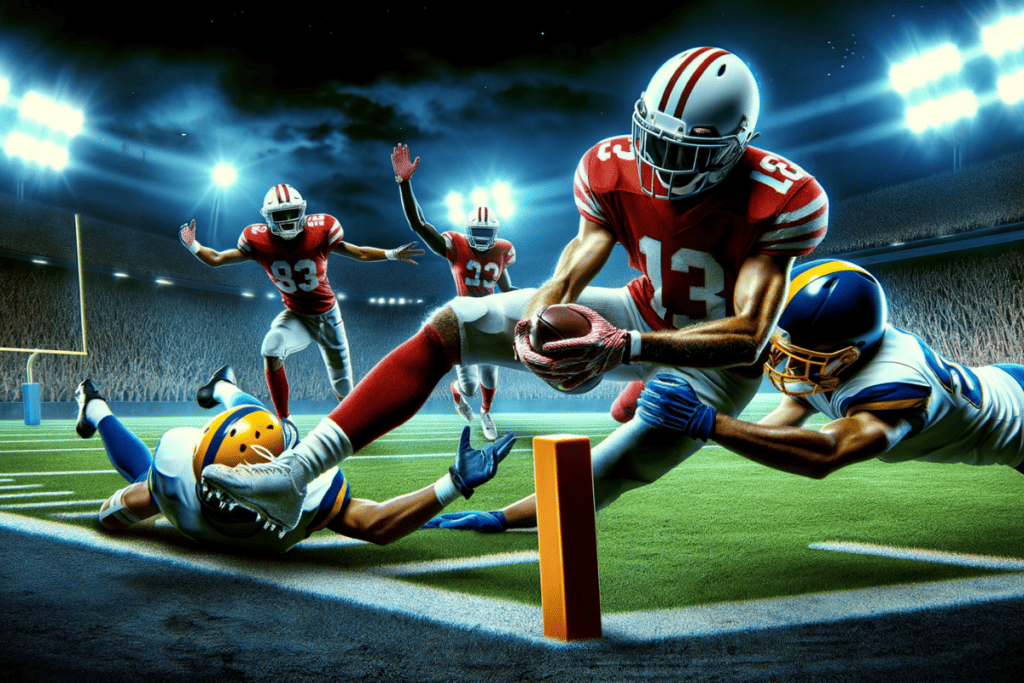What is a Pylon in Football? (and why they’re important)
In football, a pylon is a small but mighty piece of equipment. You’ve probably noticed these little orange cones placed at the corners of the end zones. They help referees make critical calls during a game, especially when it comes to scoring touchdowns or determining out of bounds plays.
The term “pylon” has its roots in architectural lingo, where it’s used to describe a monumental gateway.
But, in the early days of football, someone decided that “pylon” was a snazzy term for the markers that designate the corners of the end zone. They’ve been a part of the gridiron ever since, helping to keep the game fair and square.
Physical Characteristics of Pylons
Pylons are made to be sturdy yet flexible. They’re usually made of foam or rubber, so they can hold their shape but won’t hurt players if they crash into them.
The NFL mandates that these markers should be 18 inches tall, which is just the right height to be visible amid the chaos on the field without being a hindrance.
Color and Visibility
The fiery orange color of pylons isn’t a fashion statement. It’s so that they stand out against the green turf and the players, making them easy to spot during the game.
This high visibility helps both the referees and the audience follow the action, especially near the end zone where scoring happens.
Placement on the Football Field
Each corner of the end zone gets its own pylon, which means there are eight in total on a football field. They’re the silent guardians of the end zone, marking the boundaries where the field ends and the scoring zone begins.
This placement helps everyone involved—players, refs, and fans—know exactly where the end zone starts and ends, making it clear when a touchdown is scored or when a player steps out of bounds.
Read More:
Functions of Pylons in Football

One of the primary roles of pylons is marking the corners of the end zone. They act as silent sentinels, helping everyone in the stadium and at home know exactly where the end zone begins and ends. This clarity is crucial since scoring touchdowns is a major part of the game.
Aiding in Officiating
Pylons are more than just decorative; they are a practical tool for the referees.
- Determining Touchdowns: When a player makes a run for the end zone, whether or not they score can come down to inches. Pylons help refs make the right call. If a player has control of the ball and touches the pylon, it’s a touchdown.
- Out of Bounds Calls: Pylons also help in determining whether a player stepped out of bounds. The exact placement of these markers can significantly impact a game’s outcome.
Introduction of Pylon Cameras
With the advent of technology, pylons have gotten a techy upgrade. Pylon cameras are now a thing, and they offer a bird’s eye view of the action in the end zone.
These tiny cameras are embedded within the pylons and provide unique angles for both officiating reviews and TV broadcasts.
Advantages For Refereeing and Broadcasting
Pylon cameras have proved to be a game-changer. They provide clear, close-up views of plays, making it easier for referees to make accurate calls during crucial game moments. For audiences at home, pylon cameras enhance the viewing experience by offering dramatic, up-close footage of scoring plays and near misses.
Plus, broadcasters love them because they provide additional angles that can help explain the game’s action in real-time. This technological innovation underscores the pylons’ evolving role in modern football, bridging the gap between traditional officiating and the digital era.
Other Uses of the Term Pylon in Sports
Interestingly, the term “pylon” has also found its way into other sports vernacular. In racing, pylons are used to mark the course, showing drivers or pilots the path they need to follow. Though the application differs, the core idea remains the same: marking critical points within a competitive arena.
Conclusion
The humble pylon, with its bright orange color, stands as a crucial part of football’s rule enforcement and gameplay. Its primary roles include marking the end zone, aiding officiating, and with technological advancements, offering new perspectives for accurate refereeing and enriched viewing experiences.
Despite its simplicity, the pylon is integral to the game of football. Its presence on the field is a testament to football’s well-thought-out rules. Through its practical functions and symbolic meaning, the pylon transcends its humble appearance, emerging as a significant component of the beautiful game of football.

